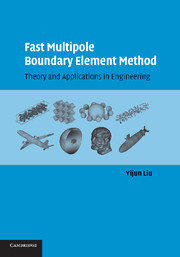Book contents
- Frontmatter
- Contents
- Preface
- Acknowledgments
- Acronyms Used in This Book
- 1 Introduction
- 2 Conventional Boundary Element Method for Potential Problems
- 3 Fast Multipole Boundary Element Method for Potential Problems
- 4 Elastostatic Problems
- 5 Stokes Flow Problems
- 6 Acoustic Wave Problems
- APPENDIX A Analytical Integration of the Kernels
- APPENDIX B Sample Computer Programs
- References
- Index
3 - Fast Multipole Boundary Element Method for Potential Problems
Published online by Cambridge University Press: 14 January 2010
- Frontmatter
- Contents
- Preface
- Acknowledgments
- Acronyms Used in This Book
- 1 Introduction
- 2 Conventional Boundary Element Method for Potential Problems
- 3 Fast Multipole Boundary Element Method for Potential Problems
- 4 Elastostatic Problems
- 5 Stokes Flow Problems
- 6 Acoustic Wave Problems
- APPENDIX A Analytical Integration of the Kernels
- APPENDIX B Sample Computer Programs
- References
- Index
Summary
Although the BEM has enjoyed the reputation of ease in modeling or meshing for problems with complicated geometries or in infinite domains, its efficiency in solutions has been a serious drawback for analyzing large-scale models. For example, the BEM has been limited to solving problems with only a few thousand DOFs on a PC for many years. This is because the conventional BEM, as described in the previous chapter, produces dense and nonsymmetric matrices that although smaller in sizes, require O(N2) operations for computing the coefficients and O(N3) operations for solving the system by using direct solvers (N is the number of equations of the linear system or DOFs).
In the mid-1980s, Rokhlin and Greengard [33–35] pioneered the innovative fast multipole method (FMM) that can be used to accelerate the solutions of BEM by severalfold, promising to reduce the CPU time in FMM-accelerated BEM to O(N). With the help of the FMM, the BEM can now solve large-scale problems that are beyond the reach of other methods. We call the fast multipole accelerated BEM fast multipole BEM or simply fast BEM from now on to distinguish it from the conventional BEM described in the previous chapter. Some of the early work on fast multipole BEMs in mechanics can be found in Refs. [36–40], which show the great promise of the fast multipole BEM for solving large-scale problems. A comprehensive review of the fast multipole BIE/BEM research up to 2002 can be found in Ref. [41].
Information
- Type
- Chapter
- Information
- Fast Multipole Boundary Element MethodTheory and Applications in Engineering, pp. 47 - 84Publisher: Cambridge University PressPrint publication year: 2009
Accessibility standard: Unknown
Why this information is here
This section outlines the accessibility features of this content - including support for screen readers, full keyboard navigation and high-contrast display options. This may not be relevant for you.Accessibility Information
- 1
- Cited by
